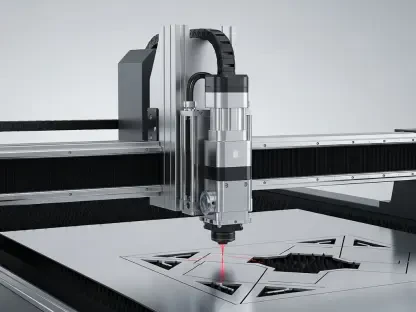The advent of Internet of Things (IoT) technology is transforming supply chains by increasing transparency and efficiency. As Canadian manufacturing facilities anticipate the benefits, IoT promises significant enhancements through accurate data collection, better monitoring, and insightful analysis. This technological leap addresses historical inefficiencies hampering operations due to data silos and disparate systems.
Enhancing Data Collection and Visibility
Bridging Data Gaps
Many organizations struggle with fragmented systems and data silos resulting from mergers and acquisitions. This fragmentation often leads to operational inefficiencies and client dissatisfaction as companies attempt to integrate various systems. IoT technology can bridge these gaps by enabling the collection of precise and detailed data on production lines, workforce activities, and product conditions.
By implementing IoT solutions, companies can gather real-time data and streamline their operations, ensuring all parts of the supply chain are clearly visible. This contributes to a more cohesive and integrated supply chain, ultimately leading to better decision-making and improved overall efficiency. For instance, IoT sensors can monitor machinery performance and predict maintenance needs before a breakdown occurs, minimizing downtime and avoiding potential disruptions.
Real-time Monitoring
With IoT, manufacturers gain the ability to monitor the location and condition of goods throughout the supply chain. The continuous exchange of real-time data allows for tracking not only the movement of products but also their condition during transit, storage, and delivery phases. This monitoring capability reduces risks associated with spoilage or damage and ensures that goods meet quality standards upon reaching their destination.
Additionally, tracking individual workers and equipment components offers comprehensive control, leading to improvements in product design, inventory management, and ordering schedules. This level of oversight can enhance operational efficiency by reducing unnecessary delays and ensuring resources are used effectively. Real-time monitoring empowers companies to respond swiftly to any anomalies, re-routing shipments or adjusting production schedules to maintain smooth flow across the entire supply chain.
Collaboration and Cost-Reduction
Strengthening Supplier Relationships
IoT-enabled insights enhance collaboration with downstream logistics partners, providing even more profound insights into the supply chain. As the integration of IoT technology becomes more accessible and cost-effective, manufacturers can achieve higher satisfaction levels with suppliers, customers, and logistics partners. Comprehensive data sharing ensures that all parties have a clear understanding of the supply chain’s status, fostering trust and teamwork.
The transparency delivered by IoT helps suppliers align better with manufacturers’ needs, leading to synchronized operations and fewer misunderstandings. This stronger collaboration translates into fewer delays, better inventory management, and ultimately, a more reliable supply chain. As a result, companies can enter new markets confidently, knowing they have robust support from their network of suppliers and logistics partners.
Cost Savings through Efficiency
Implementing IoT can lead to significant cost savings. By accurately forecasting and refining product offerings based on customer demand, manufacturers can boost labor productivity, reduce resource waste, and minimize operational and holding expenses. This approach supports on-demand production and lowers the risk associated with poor inventory management, which often leads to overstocking or stockouts.
Utilizing IoT devices enables decision-makers to streamline operations by identifying inefficiencies in the supply chain. For example, simplifying stock-keeping units by removing less popular variations can reduce excess inventory and optimize storage costs. By continuously analyzing data, companies can refine their processes, leading to incremental time and cost savings that cumulatively enhance overall operational efficiency.
IoT Applications for Quality and Safety
Combating Counterfeiting
Counterfeiting poses a significant threat to businesses, with counterfeit goods generating substantial losses globally. IoT devices can offer end-to-end traceability and remote sensing technology to verify the origins of materials, effectively mitigating the risks of counterfeiting. Remote sensing technology allows professionals to check the authenticity of products and raw materials, ensuring they meet quality and safety standards.
The use of IoT for anti-counterfeiting measures can safeguard brand reputation and protect consumers from substandard or dangerous goods. By providing a transparent supply chain, companies can build customer trust and loyalty, knowing that each product’s history is verifiable and accurate. This technological intervention reduces financial losses and helps maintain a competitive edge in the market.
Workforce and Equipment Monitoring
IoT enables real-time tracking of workers and equipment through smart tags, providing granular insights to maintain productivity and prevent workplace injuries. In the manufacturing sector, ensuring worker safety is paramount, and IoT applications can play a crucial role. Smart tags using radio frequency identification (RFID) technology can monitor worker movements and equipment usage, providing data to enhance workplace safety protocols.
This capability is invaluable to the manufacturing sector, ensuring a safer and more efficient working environment. Real-time data on equipment performance helps identify instances when machinery requires maintenance, reducing the likelihood of accidents. Additionally, tracking worker activity can highlight areas for ergonomic improvements, contributing to overall physical well-being and operational efficiency.
Future of Manufacturing
Data-Driven Decision Making
The detailed data collected from IoT applications paves the way for data-driven decision-making. These insights allow manufacturers to quickly adapt to supply chain disruptions, ensuring they remain competitive in the global market. By analyzing real-time data, companies can anticipate market trends, optimize processes, and enhance their agility in responding to changing customer demands.
Data-driven decision-making fosters continuous improvement and innovation within manufacturing operations. Detailed analytics can reveal patterns and correlations that may not be apparent through conventional methods, providing new opportunities for optimizing supply chain performance. This approach positions manufacturers to make informed decisions, driving strategic growth and competitive advantages.
Embracing Early Adoption
The rise of Internet of Things (IoT) technology is revolutionizing supply chains by boosting both transparency and efficiency. As manufacturing facilities in Canada stand on the brink of experiencing these benefits, IoT promises substantial improvements through precise data gathering, enhanced monitoring, and insightful analysis. This technological advancement is set to address long-standing inefficiencies that have hindered operations, largely due to data silos and fragmented systems. By integrating IoT, manufacturers can bridge these gaps, promoting smoother operations and better decision-making. The implementation of IoT will enable real-time tracking of materials and products, providing a clearer view of the supply chain. Such visibility ensures that any potential issues can be identified and addressed promptly, thereby minimizing delays and optimizing overall productivity. As Canadian manufacturers increasingly adopt this technology, they are likely to see significant gains, propelling them towards a more streamlined and efficient future in supply chain management.









